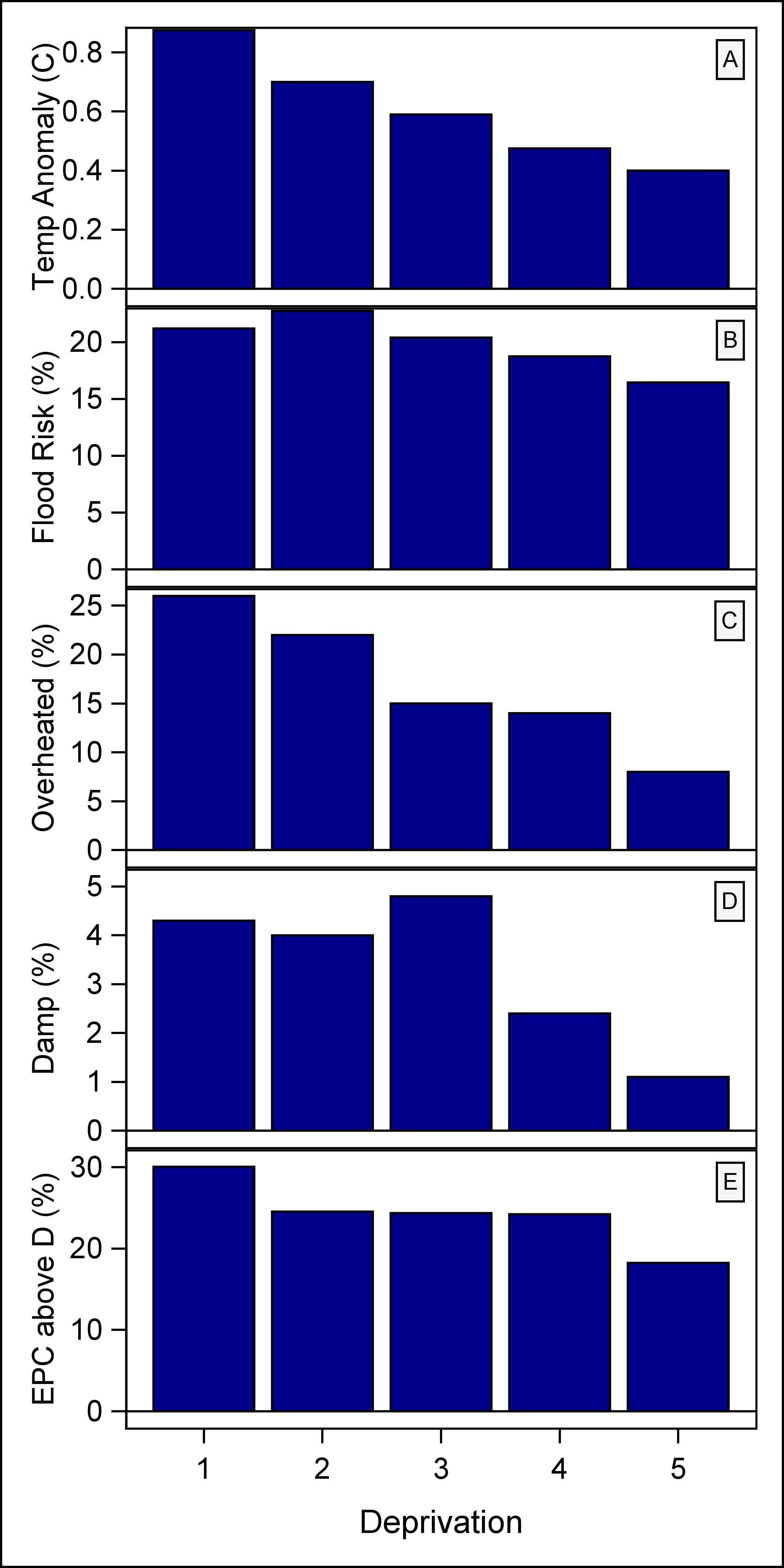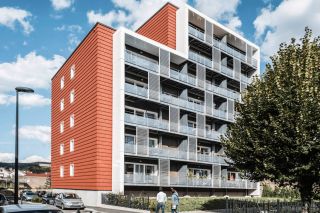
www.buildingsandcities.org/insights/commentaries/climate-justice-dwellings.html
Climate Justice and English Dwellings
By Jonathon Taylor (Tampere U, FI), Lauren Ferguson* , Anna Mavrogianni* & Clare Heaviside* (*University College London, UK)
The changing climate is expected to have a disproportionate impact on disadvantaged groups worldwide, due to greater exposure - and vulnerability - to various climate hazards. Urgent actions are needed to provide equity through not only providing mitigation measures, but also adapting homes that are most vulnerable to climate effects.

In England, climate change projections show increased average ambient temperatures, and more frequent and severe heatwave events, periods of heavy rainfall and driving rain, and flooding (Betts and Brown, 2021; Lowe et al., 2018). Such events can have serious implications for population health. Around 2,000 deaths are attributed to heat exposure each year in the UK (Hajat et al., 2014), while floods present both acute risks as well as increased levels of psychological morbidity afterwards (Jermacane et al., 2018). Indoor damp and mould growth - for example from driving rain or flooding - is associated with asthma and allergies (WHO, 2009) and poor mental health (Liddell & Guiney, 2015).
Inequality
Housing - meant to provide protection from the temperate English climate - may instead exacerbate exposures to climate hazards in vulnerable groups. Dwellings occupied by low-income communities may be more prone to indoor damp (MHCLG, 2020) and overheat more often (Lomas et al., 2021). While air conditioning in currently rare in English housing, rising temperatures may increase socioeconomic disparities, as active cooling systems are unlikely to be affordable to low-income households (O'Neill et al., 2005). Low-income communities also have higher rates of pre-existing health conditions, making them more susceptible to negative health outcomes (Marmot, 2020), have reduced resilience to damages, fewer financial means or tenure to maintain or adapt their housing, and lower political power to improve the climate resilience of their neighbourhoods. In this regard, parallels can be drawn with the current COVID-19 situation, which has highlighted inequality in England and worldwide, with mortality risks disproportionately high in lower income groups likely due to increased exposure risk, greater underlying health vulnerabilities, and limited financial resilience.
The recent COVID-19 pandemic has highlighted the role of structural inequalities on health worldwide, and without mitigation and adaptation similar health disparities will also be seen from climate change. There is now increasing evidence of unequal exposures to climate hazards in England (Figure 1), with recent studies finding that low-income communities can experience higher outdoor temperatures during heatwaves (Macintyre et al., 2018) and are at a greater risk of flooding (Hall & Bailey, 2021) relative to other income groups.
This is in contrast with the environmental impact of housing, where the dwellings of higher income groups have a disproportionately negative effect on the environment (MHCLG, 2020). The houses of higher income groups are generally larger and less energy efficient than those of lower income groups, and indeed retrofit rates are highest in low-income areas in England (Hamilton et al., 2014). This inequality between the causes and consequences of inefficiency in the housing stock indicates a degree of climate injustice.
Action
While further changes to the climate are now inevitable, there are opportunities to reduce climate injustice, both through mitigating climate change by reducing GHG emissions, whilst also adapting the built environment to the future climate. Existing inequalities highlight the need for urgent, equitable actions to transform the built environment to improve energy efficiency and climate resilience. In line with the current UK Government policy of "levelling up", government strategies should act to reduce heat and flood risks in the most exposed areas. For housing, the energy efficiency and climate resilience of the existing housing stock should be improved by central government incentives for retrofitting and energy use reduction in households with the greatest emissions. Local governments should be empowered to identify and adapt the homes and households most vulnerable to climate effects, while national building regulations should ensure new homes are adapted to future climates and aligned to climate mitigation targets. While COVID-19 underlined the existence of key structural inequalities and health, there are opportunities to proactively address issues within the built environment that contribute to climate injustice.
References
Betts, R. & Brown, K. (2021). UK Climate Change Risk Independent Assessment (CCRA3). London.
Hajat, S., Vardoulakis, S., Heaviside, C. & Eggen, B. (2014). Climate change effects on human health: projections of temperature-related mortality for the UK during the 2020s, 2050s and 2080s. Journal of Epidemiology and Community Health, 68(7): 641-48.
Hall, M. & Bailey, P. (2021). Social Deprivation and the Likelihood of Flooding. Bristol: UK Environment Agency. https://assets.publishing.service.gov.uk/government/uploads/system/uploads/attachment_data/file/953492/Social-deprivation-_and-flooding-report-v2.pdf (August 27, 2021).
Hamilton I.G., Shipworth, D., Summerfield, A.J., Steadman, P., Oreszczyn, T. & Lowe, R. (2014). Uptake of energy efficiency interventions in English dwellings. Building Research & Information 42(3): 255-75.
Jermacane, D. Waite, T.D, Beck, C.R. et al. (2018). The English national cohort study of flooding and health: the change in the prevalence of psychological morbidity at year two." BMC Public Health 18(330). https://doi.org/10.1186/s12889-018-5236-9
Liddell, C. & Guiney, C. (2015). Living in a cold and damp home: frameworks for understanding impacts on mental well-being. Public Health 129(3): 191-99.
Lomas, K. J., Watson, S., Allinson, D., Fatech, A., Beaumont, A., Allen, J., Foster, H. & Garrett, H. (2021). Dwelling and household characteristics' influence on reported and measured summertime overheating: a glimpse of a mild climate in the 2050's. Building and Environment, 201: 107986. https://doi.org/10.1016/j.buildenv.2021.107986
Lowe, Jason A. et al. (2018). UKCP18 Science Overview Report. www.metoffice.gov.uk
Macintyre, H.L, Heaviside, C., Taylor, J., Picetti, R., Symonds, P., Cai, X.M. & Vardoulakis. (2018). Assessing urban population vulnerability and environmental risks across an urban area during heatwaves - implications for health protection. Science of the Total Environment, 610-611: 678-690. https://doi.org/10.1016/j.scitotenv.2017.08.062
Marmot, M. (2020). Health equity in England: the Marmot Review 10 years on. British Medical Journal, 368:m693. https://doi.org/10.1136/bmj.m693
MHCLG. (2020). English Housing Survey, 2018: Housing Stock Data. London: UK Ministry of Housing, Communities and Local Government.
O'Neill, M.S., Zanobetti, A. & Schwartz, J. (2005). Disparities by race in heat-related mortality in four us cities: the role of air conditioning prevalence. Journal of Urban Health: Bulletin of the New York Academy of Medicine, 82(2): 191-97.
WHO. (2009). WHO Guidelines for Indoor Air Quality: Dampness and Mould. Copenhagen.
Latest Peer-Reviewed Journal Content
Acceptability of sufficiency consumption policies by Finnish households
E Nuorivaara & S Ahvenharju
Key factors for revitalising heritage buildings through adaptive reuse
É Savoie, J P Sapinski & A-M Laroche
Cooler streets for a cycleable city: assessing policy alignment
C Tang & J Bush
Understanding the embodied carbon credentials of modern methods of construction
R O'Hegarty, A McCarthy, J O'Hagan, T Thanapornpakornsin, S Raffoul & O Kinnane
The changing typology of urban apartment buildings in Aurinkolahti
S Meriläinen & A Tervo
Embodied climate impacts in urban development: a neighbourhood case study
S Sjökvist, N Francart, M Balouktsi & H Birgisdottir
Environmental effects of urban wind energy harvesting: a review
I Tsionas, M laguno-Munitxa & A Stephan
Office environment and employee differences by company health management certification
S Arata, M Sugiuchi, T Ikaga, Y Shiraishi, T Hayashi, S Ando & S Kawakubo
Spatiotemporal evaluation of embodied carbon in urban residential development
I Talvitie, A Amiri & S Junnila
Energy sufficiency in buildings and cities: current research, future directions [editorial]
M Sahakian, T Fawcett & S Darby
Sufficiency, consumption patterns and limits: a survey of French households
J Bouillet & C Grandclément
Health inequalities and indoor environments: research challenges and priorities [editorial]
M Ucci & A Mavrogianni
Operationalising energy sufficiency for low-carbon built environments in urbanising India
A B Lall & G Sethi
Promoting practices of sufficiency: reprogramming resource-intensive material arrangements
T H Christensen, L K Aagaard, A K Juvik, C Samson & K Gram-Hanssen
Culture change in the UK construction industry: an anthropological perspective
I Tellam
Are people willing to share living space? Household preferences in Finland
E Ruokamo, E Kylkilahti, M Lettenmeier & A Toppinen
Towards urban LCA: examining densification alternatives for a residential neighbourhood
M Moisio, E Salmio, T Kaasalainen, S Huuhka, A Räsänen, J Lahdensivu, M Leppänen & P Kuula
A population-level framework to estimate unequal exposure to indoor heat and air pollution
R Cole, C H Simpson, L Ferguson, P Symonds, J Taylor, C Heaviside, P Murage, H L Macintyre, S Hajat, A Mavrogianni & M Davies
Finnish glazed balconies: residents' experience, wellbeing and use
L Jegard, R Castaño-Rosa, S Kilpeläinen & S Pelsmakers
Modelling Nigerian residential dwellings: bottom-up approach and scenario analysis
C C Nwagwu, S Akin & E G Hertwich
Mapping municipal land policies: applications of flexible zoning for densification
V Götze, J-D Gerber & M Jehling
Energy sufficiency and recognition justice: a study of household consumption
A Guilbert
Linking housing, socio-demographic, environmental and mental health data at scale
P Symonds, C H Simpson, G Petrou, L Ferguson, A Mavrogianni & M Davies
Measuring health inequities due to housing characteristics
K Govertsen & M Kane
Provide or prevent? Exploring sufficiency imaginaries within Danish systems of provision
L K Aagaard & T H Christensen
Imagining sufficiency through collective changes as satisfiers
O Moynat & M Sahakian
US urban land-use reform: a strategy for energy sufficiency
Z M Subin, J Lombardi, R Muralidharan, J Korn, J Malik, T Pullen, M Wei & T Hong
Mapping supply chains for energy retrofit
F Wade & Y Han
Operationalising building-related energy sufficiency measures in SMEs
I Fouiteh, J D Cabrera Santelices, A Susini & M K Patel
Promoting neighbourhood sharing: infrastructures of convenience and community
A Huber, H Heinrichs & M Jaeger-Erben
New insights into thermal comfort sufficiency in dwellings
G van Moeseke, D de Grave, A Anciaux, J Sobczak & G Wallenborn
'Rightsize': a housing design game for spatial and energy sufficiency
P Graham, P Nourian, E Warwick & M Gath-Morad
Implementing housing policies for a sufficient lifestyle
M Bagheri, L Roth, L Siebke, C Rohde & H-J Linke
The jobs of climate adaptation
T Denham, L Rickards & O Ajulo
Structural barriers to sufficiency: the contribution of research on elites
M Koch, K Emilsson, J Lee & H Johansson
Disrupting the imaginaries of urban action to deliver just adaptation [editorial]
V Castán-Broto, M Olazabal & G Ziervogel
Nature for resilience reconfigured: global- to-local translation of frames in Africa
K Rochell, H Bulkeley & H Runhaar
How hegemonic discourses of sustainability influence urban climate action
V Castán Broto, L Westman & P Huang
Fabric first: is it still the right approach?
N Eyre, T Fawcett, M Topouzi, G Killip, T Oreszczyn, K Jenkinson & J Rosenow
Social value of the built environment [editorial]
F Samuel & K Watson
Understanding demolition [editorial]
S Huuhka
Data politics in the built environment [editorial]
A Karvonen & T Hargreaves



Latest Commentaries
Decolonising Cities: The Role of Street Naming
During colonialisation, street names were drawn from historical and societal contexts of the colonisers. Street nomenclature deployed by colonial administrators has a role in legitimising historical narratives and decentring local languages, cultures and heritage. Buyana Kareem examines street renaming as an important element of decolonisation.
Integrating Nature into Cities
Increasing vegetation and green and blue spaces in cities can support both climate change mitigation and adaptation goals, while also enhancing biodiversity and ecological health. Maibritt Pedersen Zari (Auckland University of Technology) explains why nature-based solutions (NbS) must be a vital part of urban planning and design.